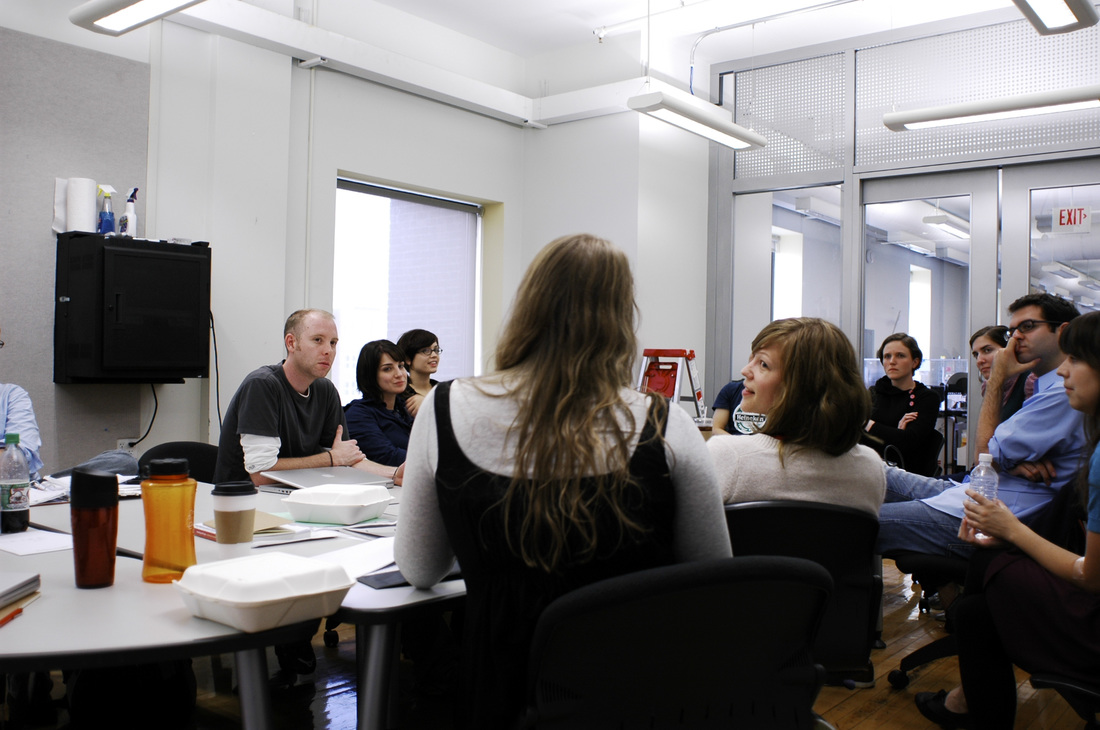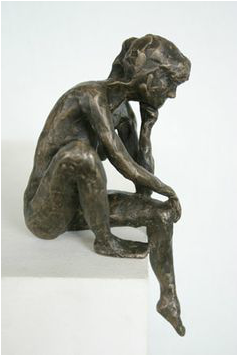|
Give journal assignments for reading and for building “chaos” for content.
The “chaos” is a series of writing-to-learn journal assignments that encourage critical thinking and builds possible content for a formal paper.
Bring primary texts together for reading, first for “bumping heads” and nuanced connection-making, and then triangulate for research purposes.
Organize small group work from sharing journals to peer review workshop.
Build transparent and collaborative community while working toward a formal paper assignment.
0 Comments
3&4) Nearly the whole of the next class is one of writing thesis statements on the board and as a class learning from and assisting to make each as effective as possible. With the time left over, I review paragraphing, incorporating quotations, including citations and documentation. The students are sent home to compose a rough draft of the paper for workshopping. (Throughout this process, from journal exercises around readings to final drafting, I encourage students who are having difficult to work with each other; to visit the writing center; and to send me in the body of an email their thesis and a paragraph of or perhaps two with a question, and I would be happy to respond with comments. I try to respond within 24 hours.)
5) In class, students form groups of threes. I attempt to engineer the make of the groups as the semester goes on to keep them fresh and not cliques. I want them to find the workshop helpful to their revision process. Later in the semester, I may quietly put weaker students with stronger students or students who are rule-bound with free thinkers. By engineering in this way I am hoping to assist each student grow. One of my favorite revision workshop templates to give each student at least two positive opinions for consideration when revising can be found in Appendix B. I will outline it here. I put the instructions on the board or distribute them as a handout. I ask each student reader to respond to each student writer in the group so that each student leaves with two sets of written (in sentences) responses to consider when revising. I ask that they write “three things that he/she likes about the paper.” As the semester progresses, I narrow the range of responses from grammar to meeting assignment expectations to developed arguments and support interpreted and its relevance explained. I also ask for “three things he/she would change if it were his/her paper.” I avoid (and ask students avoid) stating what they think is wrong with the paper, but rather to list what might need changing: argument development, underdeveloped introductions, spelling habits, etc. Writing is a difficult skill for many and focusing student writers on how they are communicating well and where they might consider change has proven an effective method. After the workshop, I review good academic-writing habits and strategies, and later in the semester, I focus on the ones with which the particular class seems to have trouble. If a workshop on introductions and conclusion or one on proofreading is needed, I usually grant it and assign it for the next class. Before the workshop class is finished, I ask students to save a copy of a rough draft because they will be including it with their final draft (with a works cited page) in a MicroSoft Word document and sending it as an attachment to me by a certain time on a certain day. I continue to be available to them via email and in person during office hours or during a previously arranged time. When grading their papers, I write in blue, commenting on the positives and negatives and suggest avenue to improvement within the paper itself, not via MicroSoft Review platform. I highlight, in tan, grammar or punctuation patterns troubling the student and refer to pages in handbooks that they might consider. When teaching Frye, I am usually teaching a course on oppression in which the class explores the tool of the powerful in philosophical thinking throughout history. I often direct students to use Frye’s essay as a lens investigate another thinker’s writing. “Lenses” are vital tools for students seeking to understand relationships of thought and to achieve perspectival thinking for themselves. Toward the end of this course the class is asked to cull the various lenses and using at least four define oppression for themselves. At this point, each is prepared to begin researching in a field. Below is an outline of scaffolding, a result of reverse-engineering, to assist students in gaining insight into a tool that may be used by oppressors. Leaving room for doubt, I allow them to read newspapers and magazines and online social media more closely to find evidence one way or another. Though often the essay author’s definition is qualified by many students, the student writing becomes one of persuasion, applying concepts, and using evidence from the world around them. My approach leans on Paulo Friere’s Pedagogy of the Oppressed and Peter Elbow’s Embracing Contraries. The strategy assumes that it is the first paper of the semester.
Two notes are worth my mentioning. 1) The instructor must find a topic and essay that interests him/her, perhaps one that is brand new to him/her so that s/he might learn something from the students or at least allow the students feel authentic interest, even excitement from the instructor. I have been interested and using the theme of oppression for several years, beginning from different points of view and ending up in a different places most of the time. I have returned to an old short essay for this example. 2) The students use journals for thinking and some drafting (homework and classwork). The journals can be on laptops on spiral-bound notebooks. A full explanation of the journal strategy can be found in Appendix C. 1. I assign for homework Marilyn Frye’s three-page essay “Oppression” asking students to read the short essay asking the males in the class to read the essay with a believing attitude and to make a list of the points in the essay with which believing was easy. (The template in Appendix A explains the strategy.) I ask the women in the class to read the essay with a doubting attitude and to make a list of the points in the essay with which doubting was easy. When class begins, I ask for lists to be read: Two from males and two from female students. I use these class readings to open discussion. After discussion, I assign small group work to consolidate the believers’ and doubters’ lines of argument. However, males may join the women and women may join the men if they find it easier to align with believer or doubter. My hope there is to establish a general belief from the class and to qualify it (and not necessarily discount Frye’s assertion). I am looking for acknowledgement that other oppressed groups also suffer double binds. 2.In small groups (usually threes), students are asked to draw a bird cage where each bar that runs over the top is designated as a double bind that women suffer. I push them to come up with at least four bars (double binds). (It is always interesting to see males and females in groups separate or mixed wrestle with the project.) Later, I ask one or two groups to draw the bird cage on the board. After discussion about women’s issues and gender issues in general, we look to see what other marginalized groups suffer double binds. Each student must come up with three or four bars to the double-binds cages. For homework they must identify and document evidence of each of the double binds in their cage (or list) in the news or magazines, and social media. When they return to class with their pieces of evidence, they work in small groups to share what each has found and discuss how each is evidence. As a class, we analyze some of the evidence so that it may stand on its own as evidence when they are asked to write a paper. (Here, pushing against the evidence, I am attempting, and tell them so, to bring greater detail and qualification to their presentation in the paper.) However, I refer to the writing and thinking done so far as chaos, but now for homework ask that students to write one or more thesis statements in their journals. We refresh our memories about what makes a thesis statement so that students don’t simple assert but also outline the arguments that they are planning to bring to bear in support of the assertion. All journal assignments are sent to students in an email also. Introduction
This series of notes will outline the general process I use for writing and thinking when teaching academic writing to first-year-students. The preparation process involves deciding what needs to be accomplished and then reverse-engineering by the instructor that results in a chain of sequenced assignments (scaffolding): 1) Reading and thinking; 2) brainstorming classwork and sharing; 3) thesis composition; 4) student thesis statement board work; 5) revision workshop; proofreading workshop; and 6) final drafting that includes a version of a rough draft attached to its final draft. I attempt to create transparent lessons that reveal pathways to writing and thinking, and these pathways are embedded in scaffolding. The sequence fits into a two to three week series of homework assignments and class times until the completion of a final draft. At the outset, students are told to use a journal for all assignments, either on a laptop or on hard copy, and that it will be graded at the end of the semester. This strategy engages students in a process of writing and thinking. Assignments are given during the course of the semester but not repeated at the end of the semester. Students either engage or lose the full notebook grade. I suggest to students that they take notice of what we do in preparation for drafting and during drafting so that they may use these strategies for reading, writing, and thinking in other courses or in work situations later in life. My students value transparency in my teaching so that they may take, strategies, techniques, templates to other reading, writing, and thinking situations. Should I design classes in which students have to guess in which of my hands the answer to the problem rests, I have become part of the problem in education. They value thinking about thinking (meta-thinking) so that they learn to ask the right questions or at least know that there are questions that will not assist them in thinking and writing. They also value developing perspectival thinking so that they own other points of view so that their perspectives grow beyond those implanted by family, schools, religions, communities, and ideologies. In Volume 1, Number 2 of The Syzygy Poetry Journal Emeniano Somoza interviews me and gets me talking about my approach to poetry. A few poems are also included in the publication. The live link is below. Thank you.
https://syzygypoetryjournal2.wordpress.com/2015/10/06/featured-poet-richard-murphy/ |
Archives
May 2024
Categories |






 RSS Feed
RSS Feed